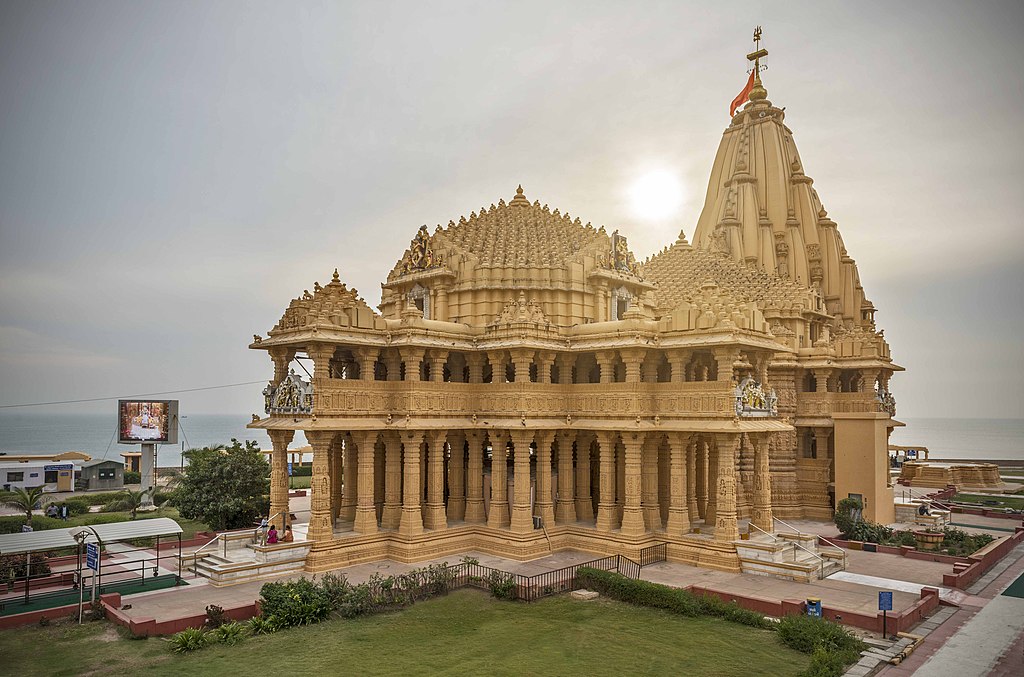Somnath Jyotirlinga
Located in Prabhas Patan, Somnath temple dedicated to Lord Shiva is revered as the first of the twelve Jyotirlingas, carrying with it a legacy of deep spiritual significance and a rich historical background.

Somnath Jyotirlinga: The Eternal Shrine of Lord Shiv
| Deity: | Shiv (Jyotirlinga) |
| State – City: | Somnath, Gujarat |
| Best time to visit | May – Jun, Sep-Oct |
| Open Hours | 4AM to 5PM and 5PM to 9PM |
| Popular festival | Mahashivratri |
FAQ
Where is Somnath temple located?
Somnath, Gujarat
What is the origin and historical significance of Somnath Temple?
The history of Somnath Temple dates back to ancient times and is deeply embedded in Hindu mythology and tradition. According to legends, the temple was originally built by the Moon God, Soma, in gold. It was later reconstructed by Ravana in silver, by Krishna in wood, and by Bhimdev in stone. The present structure, a magnificent Chalukya-style temple, was reconstructed in 1951 by the Sardar Vallabhbhai Patel-led government after repeated destruction by invaders, particularly by Mahmud of Ghazni in 1024 AD.
Who were the key figures in building or upgrading the temple?
The key figures associated with the construction and reconstruction of Somnath Temple include Soma, the Moon God; Ravana; Krishna; Bhimdev; and Adi Shankaracharya. The current temple structure was reconstructed in 1951 by the Indian government under the leadership of Sardar Vallabhbhai Patel.
What are the cultural and mythological references associated with Somnath Temple?
Somnath Temple holds a profound place in Hindu mythology. According to legend, Soma, the Moon God, was cursed by his father-in-law Daksha to lose his lustre. To restore his brilliance, Soma worshipped Lord Shiva at the spot where the temple now stands.
Pleased with his devotion, Shiva blessed him and restored his light, giving rise to the name ‘Somnath’, meaning ‘Lord of the Moon’. The temple is also referenced in ancient texts and scriptures, including the Rigveda, Skanda Purana, Shiv Purana, and Shreemad Bhagavat.
What are some unique points about Somnath Temple?
Somnath Temple is unique for several reasons:
- It is the first of the twelve Jyotirlingas, making it a paramount pilgrimage site for devotees of Lord Shiva.
- The temple’s ‘Baan-Stambh’ or arrow pillar points towards the south pole and has an inscription stating that there is no landmass between the temple and the South Pole, emphasizing its unique geographic and spiritual position.
- The temple conducts ‘Aarti’ ceremonies thrice daily, with the evening aarti being particularly spectacular against the backdrop of the setting sun and the Arabian Sea.
Why is Somnath Temple famous?
Somnath Temple is famous for its spiritual significance as the first of the twelve Jyotirlingas, its rich history of resilience against repeated invasions, and its stunning location by the Arabian Sea. The temple’s architecture, cultural rituals, and the surrounding natural beauty make it a revered site for Hindu devotees and a popular destination for tourists.
How can one reach Somnath Temple?
Somnath Temple is located in Prabhas Patan, near Veraval in Gujarat. Here are the ways to reach the temple:
- By Air: The nearest airport is Diu Airport, about 85 km from Somnath. Alternatively, one can fly to Rajkot Airport, which is around 200 km away.
- By Train: The nearest railway station is Veraval, approximately 7 km from the temple, which is well-connected to major cities in Gujarat and India.
- By Road: Somnath is accessible by road, with regular bus services and taxis available from nearby cities like Ahmedabad, Rajkot, and Diu.
When is the best time to visit Somnath Temple?
The best time to visit Somnath Temple is during the cooler months from October to March. During this period, the weather is pleasant, making the spiritual journey comfortable and memorable. The temple hosts several festivals, with Maha Shivaratri being the most significant, attracting thousands of devotees from across the country.
What makes the architecture of Somnath Temple unique?
The architecture of Somnath Temple is a magnificent example of the Chalukya style. The temple is constructed of stone and features intricate carvings depicting various deities and mythological scenes. The temple’s ‘Baan-Stambh’ or arrow pillar and its robust construction have withstood numerous invasions and natural calamities, showcasing ancient architectural ingenuity.
Somnath Temple stands as a testament to faith, resilience, and divine grace. Its spiritual significance, coupled with its rich history and breathtaking location, makes it a must-visit for devotees and travellers alike. Thank you for joining us on this journey through the sacred Somnath Temple. May your visit be filled with peace and spiritual enlightenment.







